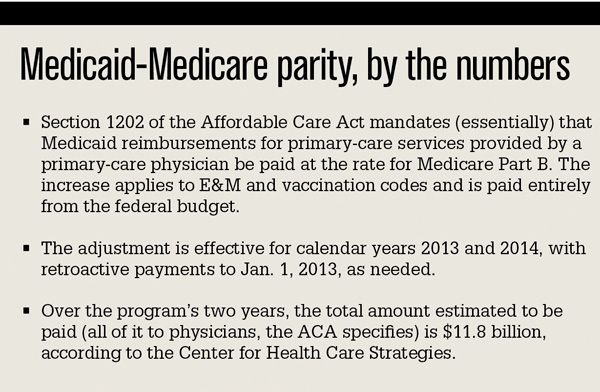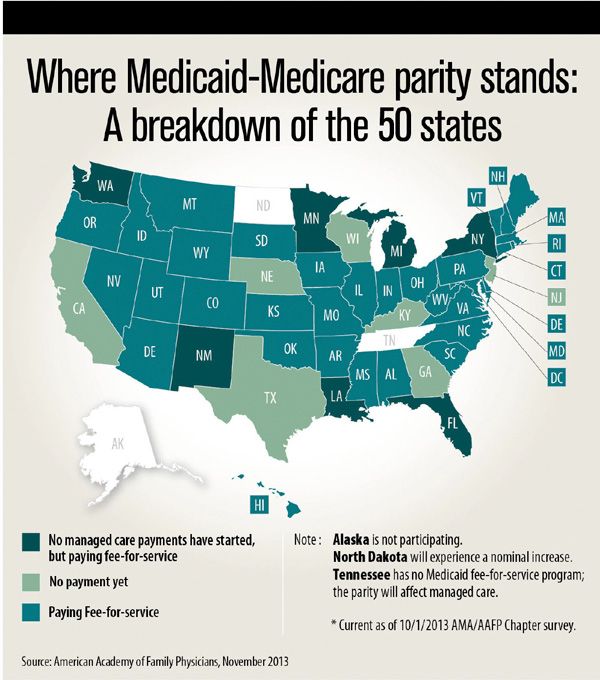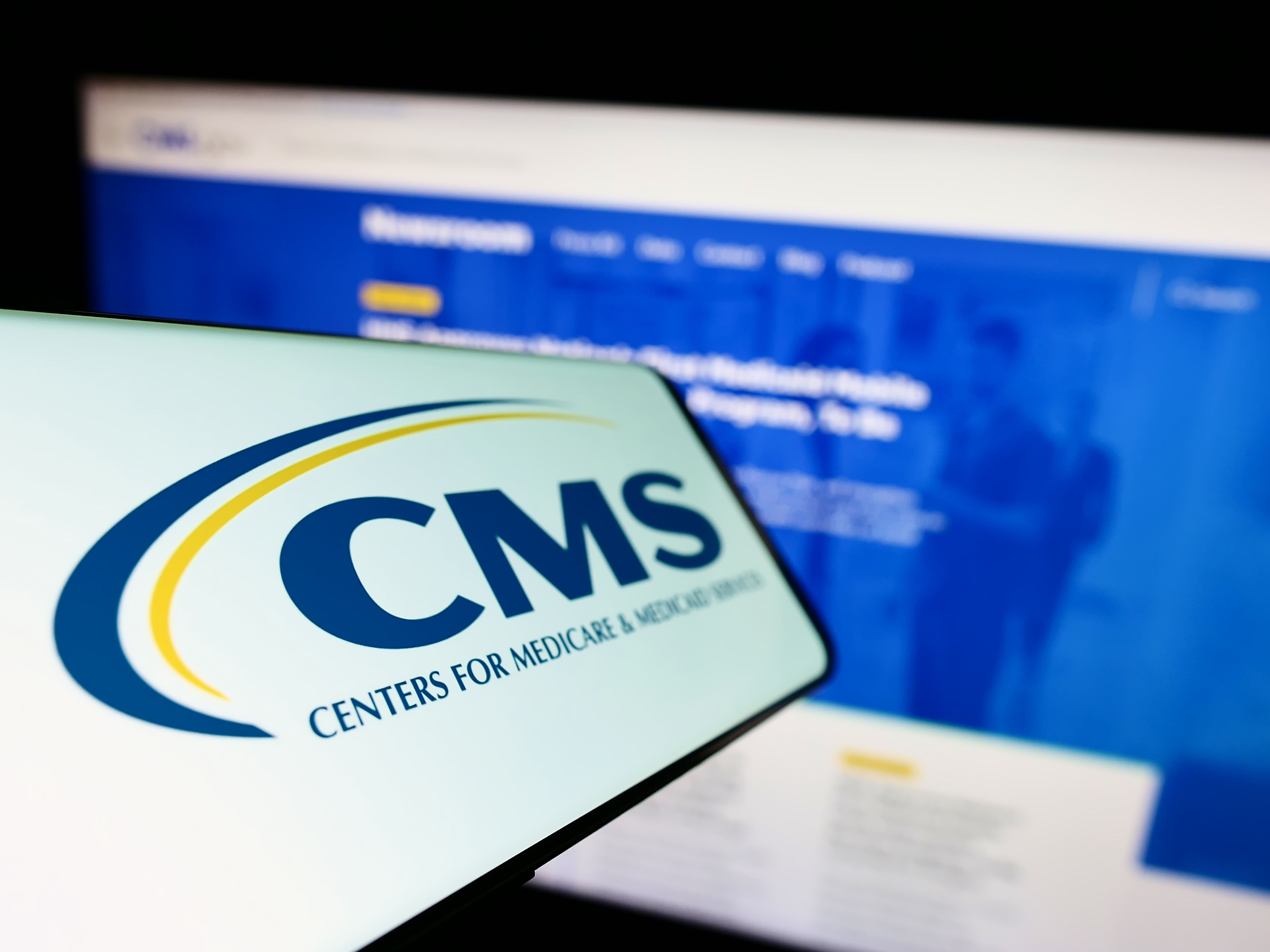Article
When will Medicaid pay primary care physicians more?
While some states have raised Medicaid payments to physicians to match Medicare reimbursements, others lag behind.
The rationale behind the Affordable Care Act’s mandate that Medicaid reimbursements for certain primary care services be increased to Medicare levels is simple: To help patients covered by Medicaid get better access to primary care by boosting the payments to the physicians who provide it. Research shows that Medicaid’s low rates are a major reason why patients find it hard to see a physician.

While parity’s purpose is simple, actually making it happen has been much more challenging. With the parity adjustment now past the halfway point in its current projected lifespan, it’s fair to ask where things stand and what might happen when parity expires-if it actually does-at the end of this year.
The two biggest factors in health outcomes, says Reid Blackwelder, MD, FAAFP, president of the American Academy of Family Physicians (AAFP), are whether an individual has healthcare coverage and whether they receive regular medical care, typically from a primary care physician.
But a big obstacle for Medicaid patients has always been the Medicaid program’s lower-than-Medicare reimbursements. Blackwelder points out that on average Medicaid pays only about two-thirds of what Medicare pays, though this varies from pre-existing parity in a couple of states (Alaska and Wyoming) to as little as one-third as much, in Rhode Island.
An August 2012 article in Health Affairs, by Sandra L. Decker of the Center for Disease Control and Prevention’s National Center for Health Statistics, reported that in a 2011 survey, nearly one-third of office-based physicians said they were unwilling to accept new Medicaid patients. The survey also found that “Higher state Medicaid-to-Medicare fee ratios were correlated with greater acceptance of new Medicaid patients.”
Other studies have also shown that reimbursement increases-along with other fixes, such as reducing administrative hassles-also increases physician participation and patient access in Medicaid, says Bob Doherty, senior vice president/governmental affairs and public policy at the American College of Physicians. He points to a September 2013 article in Health Affairs, which reported that despite concerns about Medicaid reimbursement rates, many of the physicians surveyed viewed caring for Medicaid patients as an important part of their mission.
As a result, these physicians said they struggled with serving the Medicaid population while keeping their own practices financially viable. One physician was quoted as saying, “We would accept more Medicaid patients if we could afford to do so.”
Given what’s at stake for both physicians and Medicaid patients, it’s no surprise that the implementation of parity has been closely monitored by the medical profession.
Since pediatricians are so reliant on Medicaid and the Children’s Health Insurance Program, Doherty says, the American Academy of Pediatrics (AAP) is closely tracking parity implementation.
And in September, the American Medical Association’s Advocacy Resource Center polled its state societies about the implementation of the pay parity bump, he adds. At that time, several states (including California, Georgia, New Jersey, and Texas) had yet to begin payments, and in several others (including Florida, Michigan, New York and Washington) enhanced payments had started in fee-for-service, but not in Medicaid managed care.
A few states apparently were struggling with applying enhanced payments retroactively, while others appeared to be retroactively applying the enhancement in stages.
In early November, an AAFP report, based on a survey of the group’s chapters, similarly found that Medicaid managed care programs were lagging behind enhanced fee-for-service payments.
Why did it take so long?
There are reasons, it turns out, why the rollout of Medicare-Medicaid parity has been delayed and why fee-for-service parity is well ahead of enhanced payments to Medicaid managed-care organizations.
For one, although parity became effective by law at the start of 2013, the CMS implementing regulations weren’t finished until November 2012, much later than planned, “so even after the program starts, we’re already behind,” explains Kathleen Nolan, director of state policy and programs at the National Association of Medicaid Directors.
The rate increase sounds pretty straightforward in concept, but from a technical standpoint, “it’s an incredibly complicated piece of legislation to implement,” adds Tricia McGinnis, director of delivery system reform at the Center for Health Care Strategies.
“For a state, this has been an iterative process,” says Nolan. She explains that first, a state had to submit its State Plan Amendment (SPA) relating to parity by March 31, 2013, a deadline that every state met. Then CMS had to review and approve all of the SPAs, after which the states paying Medicaid as fee-for-service could start to check physicians’s self-attestations regarding their primary care qualifications.
That was the easy part.
It’s no surprise that the managed-care side of Medicaid has been giving administrators fits, Nolan and McGinnis agree. Indeed, from their descriptions of how tricky it is for states to calculate equivalence between Medicare and Medicaid payments, it sounds like trying to figure out how many apples it takes to equal a dozen tomatoes.
Calculating the translation from Medicare fee-for-service dollars into capitated Medicaid dollars has been “a very complex process,” McGinnis says.
And it only adds more complications, Nolan explains, that Medicaid managed-care organizations generally consist of a mix of for-profit, nonprofit, and Medicaid-only providers and major health insurers, with multiple plans and contracts.
The bottom line, she says, is that “We have to get the money out the door, but we have to put an effective, useful program in place.”
In general, Nolan says, some of the initial delays were intentional, because the states did not want to move forward on their own in handling Medicaid parity until CMS issued the necessary regulations. It might have cost some time, she concedes, but it prevented the possibility that a state might issue administrative requirements, then have to change them and subject physicians and practices to additional paperwork.

Will Parity be extended?
Now that the implementation of parity seems to finally be in its home stretch, attention is likely to focus on its results, not just in helping primary care physicians stay financially solvent, but in increasing Medicaid patients’ access to primary care.
The states are generally optimistic that primary care physicians will indeed either take on Medicaid patients, or take on more of them, says McGinnis.
Blackwelder, however, expresses concern over what will happen if primary care physicians accept new Medicaid patients and parity ends. This worry is common among family practitioners with whom he has spoken, Blackwelder says. “In a sense, they’re doing this on trust.”
The potential answer is to maintain parity for at least a while longer.
In late November, the AAFP, AAP, American College of Physicians, American Congress of Obstetricians and Gynecologists, and American Osteopathic Association wrote to the chairs and ranking members of the U.S. Senate Committee on Finance and the U.S. House of Representatives Committee on Energy and Commerce. The associations urged that parity be extended for at least another 2 years, noting that the slow start-up of the parity adjustment, “combined with a lack of assurance that it will be extended beyond 2014[,] has not allowed … enough time to demonstrate the program’s effectiveness in improving access” to physician services.
The letter also prodded Congressional leaders to include ob-gyns in the parity extension. It pointed out that as of 2010, “Medicaid programs in 30 states and the District of Columbia recognized ob-gyns as primary care providers in their managed care organizations” and noted that nearly half of births in the United States are currently financed by Medicaid.
With all the complications and delays, and uncertainty about parity’s future, says Nolan, it’s easy to lose sight of that simple goal that Section 1202 of the ACA aims at: “We want more primary care delivered through Medicaid,” by getting physicians to treat, or treat more, Medicaid patients.
But, she cautions, “The jury is still out on whether we’re going to be able to do that.”





